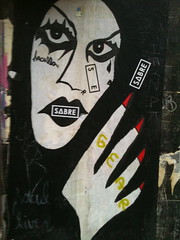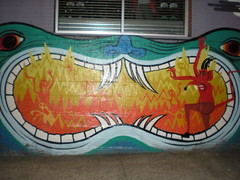In order to get everyone ready for the field work in New York, Margo gave her students the following assignment:
1. create a Flickr account
2. take a picture of a piece of public art
3. add that image to Flickr, tag it with lcnyc, and map it
In the meantime, I wrote a very basic
proof of concept page to grab the images and locations from Flickr, and put them on a Google Map. Nothing too fancy here...just hopefully an opportunity to give the students a sense of where we're headed with the bigger project, and to iron out any wrinkles we stumble upon before the real work starts.
Well, sure enough, we encountered some puzzling situations. A few images that seemingly had been done correctly on Flickr accounts were not showing up on the proof of concept page. After a fair amount of tinkering around, we discovered a few things about Flickr settings that had a direct effect upon whether an image would be included in an API query. In no particular order, here they are:
1.
Who can see this photo? - Flickr users can set their images to be viewed by anyone, only people of their choosing (friends and contacts), or only themselves. For unauthenticated API queries, images should be set so that
anyone can see them (we knew this already, but figured it was worth mentioning here).
 |
| figure 1 |
2.
Is the image hidden from public search? - Just because an image is public doesn't mean it will be included in search results. Users can opt to hide their public images from public searches (figure 1), which can be a problem if you're hoping to retrieve those images in an API or regular query. For our purposes we want images to be both public
and available for public searches.
3.
How many images does my Flickr account need until my images appear in search results? - OK, this isn't a privacy setting, but was a tricky one nonetheless. In order for images to show up on searches, an account must have at least 5 publicly available/searchable images. Thanks to Kaye Blankenship for finding this in the Flickr FAQ.
 |
| figure 2 |
4.
Who will be able to see your stuff on a map? - This was a bit of a stumper for a while...just because you map a public (and public-searchable) image on Flickr doesn't mean that the mapping is public. This can be problematic if you're using any of the "places" API methods (like
flickr.places.placesForTags). Coordinates/mapping has its own privacy setting, which Flickr users can set at the point of mapping images (figure 2).
The folks at Flickr are smart for implementing these various privacy settings, as they all serve important purposes. We just have to be aware of them when trying to build digital image collections, and set our images accordingly.







